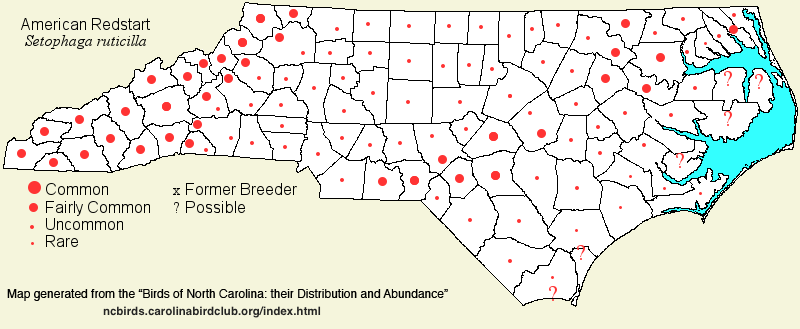 |  |
|
American Redstart - Setophaga ruticilla PARULIDAE Members: | Search Common: Search Scientific: |
|
|
||||||||
| General Comments | The very active American Redstart was, until 2011, in a genus all to itself; however, all of the former Dendroica warbler species were moved into the genus Setophaga with the redstart, as was the Hooded Warbler. The redstart's breeding range is similar to that of the Black-and-white's, covering most of the Eastern states and southern Canada. Like the Black-and-white, it has a "statewide" occurrence in North Carolina as a breeder, but with inexplicable holes in the state, especially in the Piedmont. It is a numerous transient, however, over most of the state, though it does not over-winter here. Breeding habitat is always in broadleaf deciduous forests, and almost always moist -- streamside groves, cove forests, and other moist slopes in the mountains, and mainly in wide bottomlands downstate. It is mostly absent from blackwater bottomlands/swamps, but it does occur in nonriverine sites such as the Great Dismal Swamp. Migrants can occur in many hardwood forest types, including broadleaf evergreens. | |||||||
| Breeding Status | Breeder | |||||||
| NC BRC List | Definitive | |||||||
| State Status | ||||||||
| U.S. Status | ||||||||
| State Rank | S5B | |||||||
| Global Rank | G5 | |||||||
| Coastal Plain | Summer resident, and transient. In summer, mainly uncommon and local over the region as a whole (but avoids the coast); however, common to even very common along some brownwater floodplains such as the Roanoke and the Neuse, where it is one of the most numerous breeding birds. Scarce to absent as a breeder in the southeastern part of the region. In spring, often fairly common, and common in fall, especially so along the coast. Mainly early or mid-Apr to mid-Oct. A good handful of Dec records, and two early Jan records along the southern coast; casually farther north near the coast in early winter. Peak counts: 1,000, Bald Head Island, 22 Sep 1988; 145, Run Hill State Natural Area (Dare), 21 Sep 2022. | |||||||
| Piedmont | Summer resident, and transient. In summer, breeds over most of the region, but highly local; can be common in a few extensive swamps and bottomlands, but mainly uncommon (and rare in some counties, especially in the central portion); can be fairly common in foothill ranges, at least along rivers and larger creeks. Generally common transient in both spring and fall over the region -- thus, more numerous in late Apr and May, and again in Sep, than in the nesting season. Mainly early or mid-Apr to mid-Oct. Five winter records: 1 (female), Morganton, 14-24 Jan 1993; 1, Jordan Lake, 4 Jan 1998; 1, Statesville, 27 Feb 2008; 1, on the Gastonia CBC, 16 Dec 2017; 1, Gaston, 23 Dec 2024. Peak counts: | |||||||
| Mountains | Summer resident, and transient. Breeds over the entire region; generally fairly common, mainly to 3,500 feet, but uncommon to about 4,000 feet. Not as local a breeder as in the Piedmont or Coastal Plain. Fairly common as a transient, as well. Mainly mid-Apr to mid-Oct. One at Lake Junaluska (Haywood) on 18 Nov 2019 was quite late. Peak counts: | |||||||
| Finding Tips |
The species is easy to find from late Apr into Jun along the Roanoke and Neuse rivers, such as at Howell Woods Preserve in Johnston. **** | |||||||
| Attribution | LeGrand[2025-05-09], LeGrand[2023-04-07], LeGrand[2023-03-20] | |||||||
| NC Map Map depicts all counties with a report (transient or resident) for the species. | Click on county for list of all known species. |
| NC Breeding Season Map Map depicts assumed breeding season abundance for the species. |  |